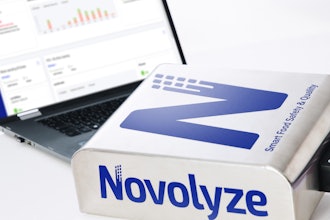
 Mark Humphlett, Senior Director of Industry and Product Marketing, Infor
Mark Humphlett, Senior Director of Industry and Product Marketing, Infor Manufacturers have become accustomed to rapid change. It’s simply part of the new normal. But, now, a new administration, a rekindled interest in restoring manufacturing jobs and political rhetoric about trade tariffs are further escalating the sense of turbulence in the industry. What can manufacturers do to manage the volatility and prepare for the future — no matter what shape it may take?
Modern software solutions, particularly cloud computing, provide valuable tools that will help manufacturers cope with escalating industry turbulence. Equipped with the right technology, manufacturers can even harness this chaotic whirlwind and turn it into an opportunity to stand apart from the competition. That highly coveted distinctive edge that all manufacturers seek may be whirling by, unnoticed.
It doesn’t have to be like that. Manufacturers simply need to spot the opportunity, analyze, formulate and act — all before an entrepreneurial upstart organization pounces first. Is that feasible?
Yes. Mastering a difficult challenge — like turbulent market conditions — is a sound tactic for differentiation. It’s a truism that is commonly observed in everyday events, in and out of manufacturing. High stress situations naturally bring out the worst in some individuals, and the best in others. Are those who excel under pressure smarter, better or stronger? No, they just are well-equipped and well-prepared to step up to the challenge.
Manufacturers can emulate that common model and take steps now to be better equipped and better prepared to face the accelerated change and disruption that is on the horizon.
Move to the Cloud
Adopting cloud computing is the first step in improving agility. It’s also the most critical. For some manufacturers, it may be a big leap. Without a cloud-based solution, though, the manufacturer who struggles with heavily modified ERP systems and cumbersome and patched legacy solutions will continually trip over outdated processes. Modifications that seemed so critical in the previous era will now slow down upgrades, complicate integrations to new technologies and weigh down the internal IT team which has to maintain support, create patches, and monitor security.
Cloud Deployment is Freeing
The IT team no longer has to bear the burden of purchasing and maintaining hardware, servers, backups and security. Upgrades become automatic, so the manufacturer can be confident they have the benefits of always modern functionality and the newest technology applications. One of the greatest benefits, though, is the speed of implementation. Typical cloud implementations take weeks, not years. This allows manufacturers to set up new divisions, acquire organizations or enter into partnerships or mergers, branch into new geographies, add new product offers or build new revenue streams quickly and easily.
Pop Up Opportunities
The agility that comes with cloud deployment means manufacturers can be alert to opportunities which may be short term or limited in scope. These pop-up, opportunistic niche markets and demand for specialty products can be highly profitable for short bursts of activity, perhaps filling a gap or a secondary market that is tied to another more far-reaching trend. For example, a manufacturer who is an early adopter of smart sensors can monetize the knowledge gained and provide benchmarks or how-to advice to others following form. That educational role may not be needed for long, as adoption becomes mainstream. But, for a window of time, expertise can be transformed into a revenue stream. Many opportunities around digital technologies and Internet of Things strategies are appearing as manufacturers transition through this revolution and seek how-to advice as well as data-based benchmarks and guidelines.
Predictive Analytics
Advanced Business Intelligence solutions provide another powerful tool manufacturers can use in the effort to stay ahead of the trends. Powerful analytics can be used to drill into historical performance — and to project future trends, even the ones that can seem at first glance to be purely random. Data Science, Machining Learning and advanced algorithms can be used to detect trends early — when there is still time to make an adjustment in go-to-market strategies, allocation of resources or planned product offerings. Anticipating market shifts allows the manufacturer to brace for the change, at least adequately prepare personnel for what is coming, whether good or bad. Being blind-sided by a sudden spike in orders can be as alarming as facing a sudden dive in customer demand. Both extremes can cause stress — easily prevented by predictive analytics.
Complete Visibility to the Supply Chain
Not every stress-causing event can be predicted. The global landscape is fraught with political unrest, ailing infrastructures and overworked systems. Such factors lead to deliveries of raw materials being lost or late to market. Vendors may be acquired or completely closed down — with orders still in the queue. A strike, hurricane, chemical spill or recall can cause havoc, interrupting the value chain for days or weeks. Customers today have zero tolerance for delays, even when the there is a logical, unavoidable reason.
The answer is to maintain complete visibility at all times with the complete network of suppliers and contractors so that changes can be made quickly — without sacrificing value or quality. The ability to make bold, confident decisions under pressure is a tremendous asset. But, the ability to make well-informed decisions that are quick — and strategically insightful — is an even greater asset. That’s where online portals, collaboration tools and integrated systems which share smart data come into play. Manufacturers who are tightly aligned with their key communities, from subcontractors to third party logistics providers, will be able to pivot and adapt to disruption — all without the customer even realizing there was a snag in the system.
Disruption is increasingly becoming a normal part of the manufacturer’s landscape. With a new administration, new technologies, and global challenges complicating the outlook, it is especially important for manufacturers to pause and consider solutions that will help them manage this upheaval. With the right technology solutions, the growth-focused manufacturer can even turn the ability to adapt into a distinctive edge.
Mark Humphlett is Senior Director of Industry and Solution Strategy at Infor.























